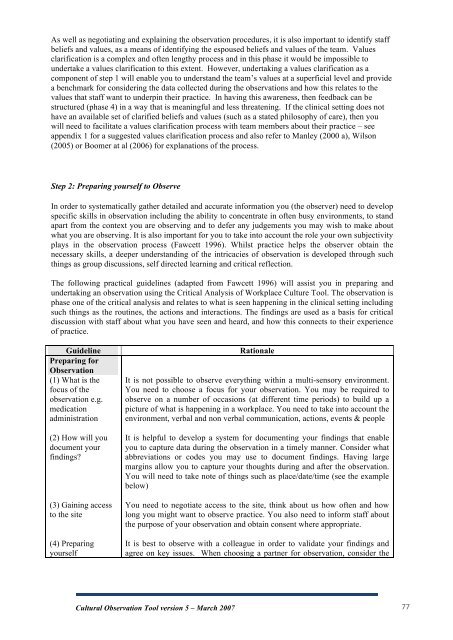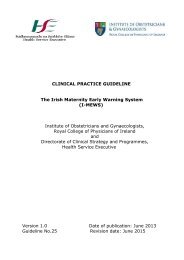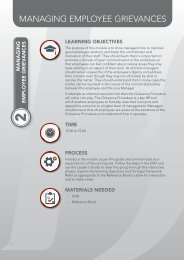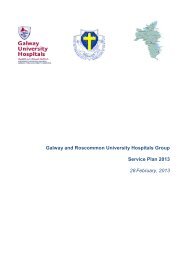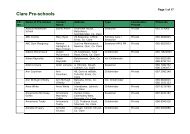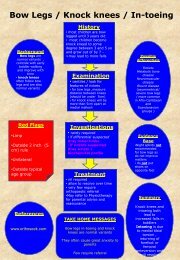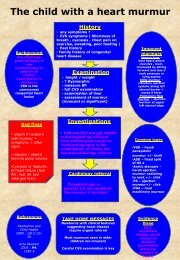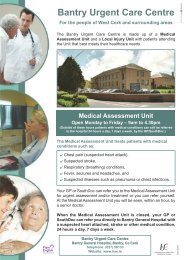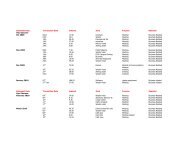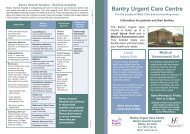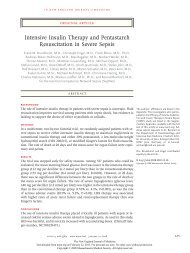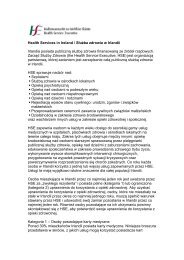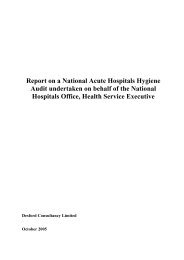Enhancing Care for Older People - Health Service Executive
Enhancing Care for Older People - Health Service Executive
Enhancing Care for Older People - Health Service Executive
Create successful ePaper yourself
Turn your PDF publications into a flip-book with our unique Google optimized e-Paper software.
As well as negotiating and explaining the observation procedures, it is also important to identify staff<br />
beliefs and values, as a means of identifying the espoused beliefs and values of the team. Values<br />
clarification is a complex and often lengthy process and in this phase it would be impossible to<br />
undertake a values clarification to this extent. However, undertaking a values clarification as a<br />
component of step 1 will enable you to understand the team’s values at a superficial level and provide<br />
a benchmark <strong>for</strong> considering the data collected during the observations and how this relates to the<br />
values that staff want to underpin their practice. In having this awareness, then feedback can be<br />
structured (phase 4) in a way that is meaningful and less threatening. If the clinical setting does not<br />
have an available set of clarified beliefs and The values WCCAT (such has as a been stated developed philosophy to help of care), people then involved you in the<br />
will need to facilitate a values clarification process development with of team practice members to undertake about their observational practice – studies see of work<br />
appendix 1 <strong>for</strong> a suggested values clarification place process settings and in also order refer to in<strong>for</strong>m to Manley changes (2000 in practice. a), Wilson The tool is<br />
(2005) or Workplace<br />
Boomer at al (2006) <strong>for</strong> explanations suitable of the <strong>for</strong> process. use by anyone who has some experience of practice<br />
development including the observation of practice. The tool has<br />
been developed from an analysis of our experience of leading and<br />
facilitating practice development programmes over many years.<br />
Observation is one of the key tools used in emancipatory<br />
Step 2: Preparing yourself to Observe practice development – a <strong>for</strong>m of practice development that is<br />
Culture<br />
concerned with changing the culture and context of practice in order<br />
In order to systematically gather detailed and to accurate develop in<strong>for</strong>mation sustainable you person-centred (the observer) and need to evidence-based develop<br />
specific skills in observation including the ability workplaces. to concentrate Seeing practice, in often raising busy consciousness environments, about to stand taken <strong>for</strong><br />
granted practices and reflecting on taken <strong>for</strong> granted assumptions<br />
apart from the context you are observing and to defer any judgements you may wish to make about<br />
are key components of comprehensive observation. This tool is<br />
what you are observing. It is also important <strong>for</strong> you to take into account the role your own subjectivity<br />
designed to help you develop a systematic approach to undertaking<br />
plays in the observation process (Fawcett Critical<br />
these 1996). activities. Whilst practice helps the observer obtain the<br />
necessary skills, a deeper understanding of the intricacies We encourage of observation you to use is this developed tool and through would such welcome<br />
things as group discussions, self directed learning your feedback and critical on reflection. its relevance and usability in your practice<br />
development work.<br />
The following practical guidelines (adapted from Contact Fawcett 1996) will assist you in preparing and<br />
undertaking an observation using the Critical Analysis Brendan of Workplace McCormack: Culture bg.mccormack@ulster.ac.uk<br />
Tool. The observation is<br />
phase one Analysis<br />
of the critical analysis and relates to what Liz is seen Henderson happening liz.henderson@bch.n-i.nhs.uk<br />
in the clinical setting including<br />
such things as the routines, the actions and interactions. <strong>for</strong> further The in<strong>for</strong>mation. findings are used as a basis <strong>for</strong> critical<br />
discussion with staff about what you have seen and heard, and how this connects to their experience<br />
of practice.<br />
Tool<br />
Guideline Rationale<br />
Preparing <strong>for</strong><br />
Observation<br />
(1) What is the It is not possible to observe everything within a multi-sensory environment.<br />
focus of the You need to choose a focus <strong>for</strong> your observation. You may be required to<br />
observation<br />
ORIGINAL<br />
e.g.<br />
AUTHORS<br />
observe on a<br />
OF<br />
number<br />
THE<br />
of<br />
WCCAT<br />
occasions (at different time periods) to build up a<br />
medication picture of what is happening in a workplace. You need to take into account the<br />
o Brendan McCormack, Professor of Nursing Research University of Ulster and<br />
administration environment, verbal and non verbal communication, actions, events & people<br />
Director of Nursing Research and Practice development, Royal Hospitals Trust,<br />
(2) How will Belfast. you It is helpful to develop a system <strong>for</strong> documenting your findings that enable<br />
document o your Elizabeth you Henderson, to capture Lead data Cancer during the Nurse, observation Northern in a Ireland timely Cancer manner. Network. Consider what<br />
findings?<br />
o Dr Val Wilson,<br />
abbreviations<br />
Director<br />
or<br />
of<br />
codes<br />
Nursing<br />
you<br />
Research<br />
may use<br />
&<br />
to<br />
Practice<br />
document<br />
Development,<br />
findings. Having<br />
the Children's<br />
large<br />
margins allow you to capture your thoughts during and after the observation.<br />
Hospital at You Westmead, will need NSW, to take Australia. note of things such as place/date/time (see the example<br />
below)<br />
o Jayne Wright, Research Associate, University of Ulster<br />
(3) Gaining access<br />
to the site<br />
(4) Preparing<br />
yourself<br />
April 2007<br />
You need to negotiate access to the site, think about us how often and how<br />
long you might want to observe practice. You also need to in<strong>for</strong>m staff about<br />
the purpose of your observation and obtain consent where appropriate.<br />
It is best to observe with a colleague in order to validate your findings and<br />
agree on key issues. When choosing a partner <strong>for</strong> observation, consider the<br />
Cultural Observation Tool version 5 – March 2007 6<br />
Cultural Observation Tool version 5 – March 2007 1 77<br />
77


